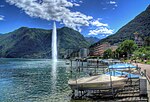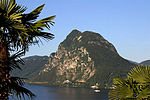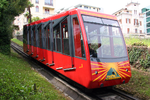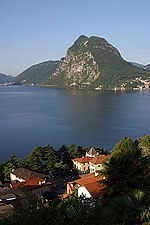Lake Lugano

Lake Lugano (Italian: Lago di Lugano or Ceresio, from Latin: Ceresius lacus; Lombard: Lagh de Lugan) is a glacial lake which is situated on the border between southern Switzerland and northern Italy. The lake, named after the city of Lugano, is situated between Lake Como and Lago Maggiore. It was cited for the first time by Gregory of Tours in 590 with the name Ceresio, a name which is said to have derived from the Latin word cerasus, meaning cherry, and refers to the abundance of cherry trees which at one time adorned the shores of the lake. The lake appears in documents in 804 under the name Laco Luanasco. There are various mountains and tourist destinations on the shores of the lake including Monte Brè to the east, Monte San Salvatore west of Lugano, and Monte Generoso on the south-eastern shore. The World Heritage Site Monte San Giorgio is situated south of the lake. Also located to the south is the Cinque Vette Park. The lake is drained by the Tresa, which empties into Lake Maggiore, the latter being drained by the Ticino and the Po.
Excerpt from the Wikipedia article Lake Lugano (License: CC BY-SA 3.0, Authors, Images).Lake Lugano
Geographical coordinates (GPS) Address Website Nearby Places Show on map
Geographical coordinates (GPS)
| Latitude | Longitude |
|---|---|
| N 45.983333333333 ° | E 8.9666666666667 ° |
Address
Campione d'Italia
22061
Lombardy, Italy
Open on Google Maps









